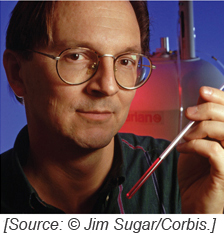Chapter Introduction
1: Evolution, Science, and Molecular Biology
1
MOMENT OF DISCOVERY

A big question in the origin of life concerns how primitive cells might have evolved. My own approach to this question involved lots of discussions with Irene Chen and others in my lab about how lipid vesicles containing RNA, which might mimic a simple self-
More recently, we found that vesicles loaded with RNA can also take up nucleotides (the building blocks of RNA and DNA) from the environment, disproving an old idea that it would be hard for primitive cells to survive by taking up small molecules, including negatively charged nucleotides, from their surroundings. It has been very exciting to find that each potential roadblock to primitive cellular replication that we have explored so far can be overcome, often without requiring specialized catalysts or input energy.
—Jack Szostak, on his discovery of self-
2
Born in the second half of the twentieth century, molecular biology has only recently come of age. Broadly speaking, molecular biology is the study of essential cellular macromolecules, including DNA, RNA, and proteins, and the biological pathways between them. Over the decades, molecular biology has become firmly associated with the structure, function, and regulation of information pathways at the molecular level. All of the processes required to reliably pass genetic information from one generation to another and from DNA to RNA to protein are included in this area of study. Of the requirements for life, it is the information in our genetic material that links all organisms to each other and documents their intertwined history. The biological information pathways that maintain, use, and transmit that information are the focus of this book.
Molecular biology may have a relatively short history, but its impact on the human experience is already considerable. Medicine, modern agriculture, forensic science, and many other endeavors rely on technologies developed by molecular biologists. Our current understanding of information pathways has given rise to diagnostic tests for genetic diseases, forensic DNA analysis, crops with improved yields and resistance to disease, new cancer therapies, an unprecedented ability to track pandemics, new wastewater treatment methods, new approaches to the generation of energy, and much more. Many of these advances are chronicled throughout this textbook.
This first chapter introduces three of the most important themes that link the book’s topics. The first theme concerns the two key requirements for life: biological information, the genetic instructions that shape every living cell and virus, and catalysis, a capacity to accelerate critical molecular processes. Molecular biology deals with both, and much of the discipline focuses on the interplay between information-
The second theme is evolution. Many of the processes we will consider can be traced back billions of years, and a few can be traced to the last universal common ancestor. Genetic information is a kind of molecular clock that can help define ancestral relationships among species. Shared information pathways connect humans to every other living organism on Earth and to all the organisms that came before.
The third theme in this book is how we look at molecular biology as a scientific endeavor. Any scientific discipline is a construct not only of the knowledge it has generated but also of the human processes behind that knowledge. Molecular biology has both an inspirational history and a promising future, to be forged by contributors as yet unnamed. Breakthroughs rely on more than technology and ideas: they require an understanding of the scientific process and are informed by the struggles of the past.